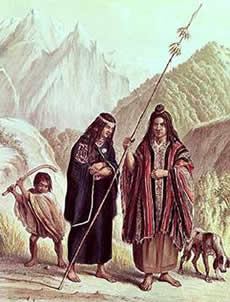 |
| Araucanian Indians |
Occupying the western slopes of the Andes in the fertile lands between roughly 30 and 43 degrees south latitude, the Araucanians were loosely incorporated into the Inca realm in the late 1400s, though Inca influence was never strong.
Sedentary agriculturalists who cultivated corn, beans, and other crops, the Araucanians were less a unified polity than a series of independent chieftaincies sharing the same language and broadly similar social and cultural attributes.
The first Spanish incursion into the area, led by Diego de Almagro in 1535–37, met with bitter disappointment. The second, led by Pedro de Valdivia beginning in 1540, was nominally more successful. In 1541, Valdivia founded Santiago and a number of lesser settlements. After returning to Peru in 1547 and helping suppress the rebellion of Gonzalo Pizarro, Valdivia was named governor of Chile.
 |
From 1549, he continued his effort to conquer the Araucanians, marching south to the Bío-Bío River and founding the fortress-towns of Concepción (1550) and Valdivia (1552). Dividing subjugated Indians into encomiendas and heartened by reports of large deposits of gold, Valdivia encouraged miners and prospectors to stream into the district.
In 1553, a large force of Araucanians from the province of Tucapel and under the leadership of the chieftains Lautaro and Caupolicán launched a counterattack that annihilated an entire Spanish expedition, including Governor Valdivia, whom they ate in ritual cannibalism. A general uprising continued for four years. Their exploits were immortalized in the epic poem La Araucana (pub. 1569–89) by the Spanish poet Alonso de Ercilla y Zúñiga.
A brutal war followed. In 1598, victorious Araucanians captured and ate Governor Martín García de Loyola. By 1600, the successors of Lautaro and Caupolicán had destroyed most of the nascent Spanish settlements south of the Bío-Bío.
Over the next two centuries, there emerged a complex military and political struggle, as the Spanish settlements slowly grew and groups of Araucanians rose in major uprisings in 1723, 1740, and 1776.
Scholars have emphasized the internal transformations in Araucanian culture, politics, and militarism, and the role played by Spanish deserters, as key to their long success in resisting Spanish domination. They were not militarily conquered until 1883, while their cultural influence remains strong in Chile today.
EmoticonEmoticon